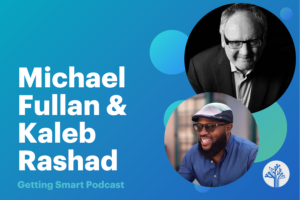3 Necessary Skills for Educators in the Era of A.I.

By Raj Shah
By now, we’ve all heard the warnings: artificial intelligence is on its way, and it’s going to radically change education, business, healthcare, and every other sector.
It’s time we considered the increasing impact of AI in education. Educators have already previewed examples of the changes coming their way. Automation technology has been introduced for a variety of basic teaching tasks.
- Tools like Gradecam and Gradescope can take over grading. AI makes it possible for these tools to read handwriting and score exams efficiently.
- Educational software like IBM’s Watson teaches by adapting to every student’s experience, needs, and learning style.
- Amy is an AI-powered app that tutors math lessons.
If you’re an optimist, you’re excited to use these advancements to complement your teaching style. On the other hand, you might be a little concerned that a robot will replace you in the next 3-10 years. In any case, the time to prepare for these changes is now.
By practicing and sharpening our human strengths (in other words – robots’ weaknesses), we can improve our chances of thriving in a world where AI is ubiquitous in every classroom, school and home.
Here are 3 skills to start honing today that give educators an advantage over AI.
1) The Skill of Generating Ideas (Creativity)
Creativity is a skill practiced to help regular people become original thinkers. The writer W. E. B. DuBois once wrote, “He was one of you, and yet he became Abraham Lincoln.”
Every person is wired with the ability to generate original ideas, in the same way that artificial intelligence is coded with the ability to process large data sets. The advantage that we have as humans is that we’re more artistic, while AI is more logical.
Humans specialize in using our imagination, emotions, intuition, and holistic thinking. That’s how we generate ideas, and by honing this skill, educators can pump out more ideas than ever before. These ideas assist them in delivering learning experiences in ways that AI can’t.
Idea generation is an underused skill. Many people think it’s a talent better left to entrepreneurs, scientists, or artists. But it is absolutely necessary in the classroom as well.
Here are 22 ideas to start harnessing more creativity in the classroom.
2) The Skill of Storytelling
“After nourishment, shelter, and companionship, stories are the thing we need most in the world.” – Philip Pullman
Generating and telling stories is a uniquely human skill educators can bring to the table that AI can’t in the immediate future. As of now, technologists aren’t focusing on building AI to viscerally tell stories or connect with audiences.
An educator can maintain an advantage over AI with their ability to take complex ideas and dull information, and illustrate these concepts through stories.
Storytelling has proven to “light up” brains in an audience. Learn more about the neuroscience of storytelling and start making a conscious effort to teach new concepts using stories.
3) The Skill of Continual Improvement
Successful professionals thrive on continual improvement, a metacognitive skill. They adapt to their surroundings and are constantly looking for ways to expand their knowledge.
In the future, more professionals will possess a “T-shaped” skill set–that is, they’ll develop general knowledge across many fields, and deep knowledge and ability in one field.
In many ways, teachers today already have T-shaped skill sets, in that they may specialize in teaching math, but also know other subjects. Here’s an example of what a T-shaped teacher looks like:

Never stop looking for ways to make yourself more valuable to your employer in the era of AI. As time-consuming tasks like grading homework are delegated to AI, take advantage of sites like Coursera, TakeLessons, Udemy, and Udacity to broaden your skillset.
Learn skills like sign language or coding that are becoming more and more desired in the workforce. You might also benefit from taking a free intro course on AI to understand its vast capabilities and potential.
Also, keep in mind that the T-shaped teacher isn’t afraid of working with or coexisting with AI. He or she is flexible with change and uses AI to their advantage.
Look for ways to use AI to complement your teaching methods. Accept and embrace the changes that are coming our way, and stay up to date with advancements in education technology.
Final Thoughts
Teachers need to continue sharpening the skills that make them increasingly valuable to their schools – skills that come naturally to us such as storytelling, creativity and continual improvement.
These skills represent the best of human intelligence and will help secure our roles in the classroom, even with the rise of AI.
For more, see:
- Ask About AI: The Future of Learning and Work
- Artificial Intelligence in Education: Where It’s At, Where It’s Headed
- The Future of Skills: Employment in 2030
Raj Shah is a senior manager at TakeLessons. Find him on the TakeLessons blog, or on Twitter @rajshahchicago
Stay in-the-know with all things EdTech and innovations in learning by signing up to receive the weekly Smart Update.






0 Comments
Leave a Comment
Your email address will not be published. All fields are required.